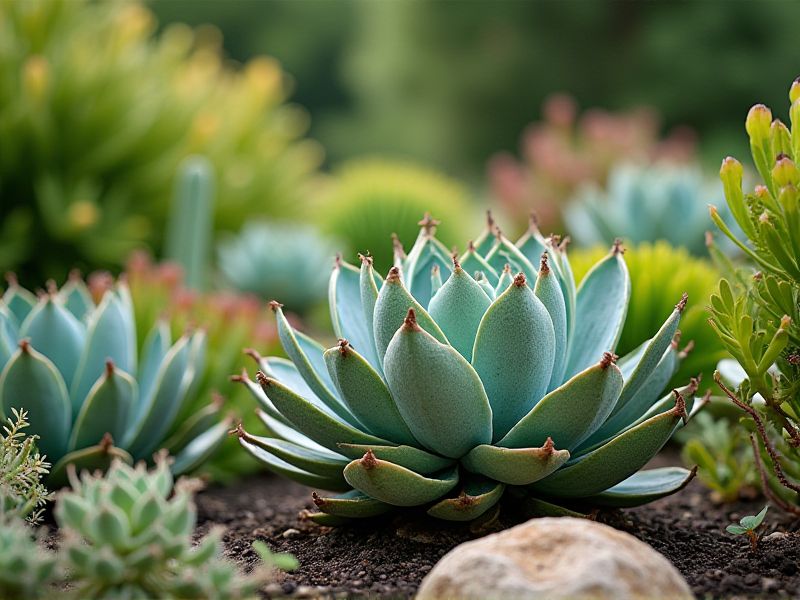
Xeriscape plants are specifically designed to thrive in arid conditions while minimizing water use. Popular choices include succulents like Sedum and Agave, which store water in their leaves and require minimal irrigation. Ornamental grasses, such as Blue Fescue and Japanese Blood Grass, not only enhance visual appeal but also adapt well to dry environments. You might also consider flowering perennials like Lavender and Coneflower, which attract pollinators while flourishing with limited watering. Incorporating these drought-resistant plants into your landscape can significantly reduce water consumption and promote a sustainable environment.
List of some Xeriscape plants that conserve water
- Lavender (Lavandula)
- Agave (Agave americana)
- Russian Sage (Perovskia atriplicifolia)
- Yarrow (Achillea millefolium)
- Red Yucca (Hesperaloe parviflora)
- Sedum (Sedum spp.)
- Coneflower (Echinacea purpurea)
- California Poppy (Eschscholzia californica)
- Desert Marigold (Baileya multiradiata)
- Blue Fescue (Festuca glauca)
Important things about Xeriscape plants that conserve water
Definition Of Xeriscaping
Xeriscaping is a sustainable landscaping approach that emphasizes water conservation through the use of drought-resistant plants. These xeriscape plants, such as succulents, native grasses, and perennials, are specifically chosen for their ability to thrive in arid climates with minimal irrigation. By selecting species like lavender, agave, and ornamental grasses, you can create a vibrant landscape while significantly reducing water usage. Implementing xeriscaping not only enhances the aesthetic appeal of your garden but also promotes environmental sustainability by preserving valuable water resources.
Native Plant Selection
Xeriscape plants are specifically chosen for their ability to thrive in dry conditions while conserving water, making them an ideal choice for sustainable landscaping. Native species such as lavender, sage, and yarrow not only enhance the aesthetic appeal of your garden but also attract beneficial pollinators like bees and butterflies. These plants typically have deep root systems that allow them to access moisture from the soil, minimizing the need for supplemental watering. By integrating xeriscape plants into your landscape, you contribute to water conservation efforts while creating a diverse and resilient ecosystem.
Drought-Resistant Species
Xeriscape plants are specifically chosen for their ability to thrive in arid conditions while minimizing water consumption. These drought-resistant species, such as lavender, agave, and succulents, are not only visually appealing but also enhance the ecological balance of your garden. Incorporating these plants into your landscape design can significantly reduce irrigation needs, making them an eco-friendly choice. By selecting native and adapted species, you can create a resilient garden that conserves water and supports local wildlife.
Soil Amendment Benefits
Incorporating soil amendments, such as organic matter or biochar, enhances the water retention capacity of soil, which is crucial for Xeriscape plants that thrive in arid conditions. By improving soil structure and aeration, these amendments facilitate deeper root growth, allowing plants to access moisture more efficiently. This adaptation not only conserves water but also supports plant health, promoting vibrant foliage and blooming. You can achieve maximum benefits by regularly testing your soil and adjusting amendments to optimize the environment for drought-tolerant species.
Efficient Irrigation Techniques
Xeriscape plants are specially designed to thrive in dry environments, significantly reducing the need for irrigation. By incorporating drought-tolerant species such as succulents, native grasses, and certain flowering plants, you can create a vibrant landscape that minimizes water usage. Efficient irrigation techniques, including drip systems and rainwater harvesting, further enhance water conservation efforts in xeriscaping. This approach not only promotes sustainable gardening but also preserves local ecosystems by using less groundwater.
Mulching Importance
Mulching is essential for Xeriscape plants as it significantly conserves soil moisture, reducing the need for frequent watering. By creating a barrier, mulch helps regulate soil temperature and minimizes evaporation, which is crucial in arid climates where water conservation is a priority. Organic mulch, such as wood chips or straw, not only enriches the soil as it breaks down but also suppresses weed growth, allowing your Xeriscape plants to thrive without competition for nutrients. Implementing a mulching strategy can enhance the overall health and sustainability of your drought-tolerant landscape.
Seasonal Maintenance Practices
Xeriscape plants are specifically chosen for their ability to thrive in arid climates, making them ideal for conserving water in your landscape. Incorporating native species such as lavender, agave, and succulents can significantly reduce irrigation needs while adding vibrant aesthetics to your garden. Seasonal maintenance practices, like mulching around these plants, help retain moisture and minimize evaporation, further enhancing their drought-resistant characteristics. Regular checks for pests and diseases ensure that your xeriscape remains healthy, maximizing its water-saving potential and beauty.
Microclimate Creation
Xeriscape plants are specifically selected for their ability to thrive in arid environments while significantly conserving water. By incorporating native species such as succulents, drought-resistant grasses, and colorful flowering shrubs, you can create a vibrant landscape that minimizes the need for irrigation. These plants not only tolerate dry conditions but also promote a unique microclimate that supports local wildlife and enhances soil health. Implementing strategies like mulch application and strategic spacing further optimizes water retention and energy efficiency in your garden.
Biodiversity Promotion
Xeriscaping employs drought-resistant plants that thrive in arid conditions, significantly reducing water usage in landscaping. Plants such as succulents, ornamental grasses, and native species like lavender and sage not only conserve water but also support local ecosystems by attracting pollinators. By incorporating these xeriscape plants into your garden, you can create a vibrant, low-maintenance space that enhances biodiversity. This sustainable landscaping approach plays a crucial role in conserving natural resources while providing habitat for wildlife.
Environmental Impact Reduction
Xeriscape plants are specifically designed to thrive in dry climates, significantly reducing the need for supplemental watering and conserving precious water resources. By incorporating drought-resistant species such as succulents, ornamental grasses, and native plants, you can create a visually appealing landscape while minimizing environmental impact. These plants not only require less maintenance but also support local ecosystems by attracting beneficial insects and wildlife. Transitioning to a xeriscape garden can lead to substantial water savings, making it an eco-friendly choice for sustainable landscaping.
